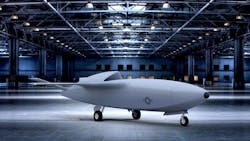Air Force picks four U.S. contractors to build unmanned combat aircraft with artificial intelligence (AI)
WRIGHT-PATTERSON AFB, Ohio – Four U.S prime defense contractors will share as much as $400 million to develop a prototype low-cost unmanned combat aircraft with artificial intelligence (AI) and modular payloads for a wide variety of fighter and ground-attack capabilities.
Officials of the U.S. Air Force Life Cycle Management Center at Wright-Patterson Air Force Base, Ohio on Thursday named the Boeing Co. Defense, Space & Security segment in St. Louis; General Atomics Aeronautical Systems Inc. in Poway, Calif.; the Kratos Defense & Security Solutions Inc. Unmanned Systems segment in Oklahoma City, Okla.; and the Northrop Grumman Corp. Aeronautics segment in Palmdale, Calif., for the Skyborg Vanguard program.
Skyborg will be an unmanned autonomous attritable aircraft to generate massed combat power, and fight and win against enemies with capabilities similar to those of the U.S. It will have modular hardware and software, as well as the future Skyborg autonomy core system that will enable teaming among manned and unmanned aircraft.
The Skyborg project will develop a prototype inexpensive, quick-turnaround, autonomous unmanned fighter-like aircraft that will be able to accommodate increasingly complex electronic and aeronautical technologies.
Advanced autonomy and AI are poised to change the character of the international battlefield substantially in the near future, Air Force researchers explain. Researchers want to field an autonomous combat aircraft that meets an immediate operational need, as well as that can jump-start complex AI development, prototyping, experimentation, and fielding.
Skyborg will be attritable, meaning it will have a low-enough cost to sacrifice in combat to attack high-value targets. It also will be reusable after flying routine missions. It also have autonomy necessary to compose and select independently among different courses of action.
Its AI embedded computing will have modular components and protocols that conform to open-systems standards, which integrate easily with third-party products. Open systems mitigate risks of technology obsolescence, vender-unique technology, and single sources of supply and maintenance, Air Force researchers explain.
Skyborg must have an open AI software architecture and toolkits that enable timely modifications and upgrades of complex autonomous behaviors; have modular open-systems mission hardware; and meet military certification and acquisition requirements.
From Skyborg, Air Force researchers also the ability to avoid other aircraft, terrain, obstacles, and hazardous weather without human intervention; conduct autonomous takeoffs and returns; have separate sensor payloads and flight computers that allow for modular adjustments and adaptability; and have mission-planning software that integrates with next-generation Air Force mission planning tools that emphasize modularity and openness.
Researchers also want an autonomous aircraft that can operate with personnel who have limited engineering or pilot experience. On these contracts Boeing, General Atomics, Kratos, and Northrop Grumman will do the work at locations to be determined at the order level, and should be finished by July 2026.
For more information contact Boeing Defense, Space & Security online at www.boeing.com/company/about-bds; General Atomics Aeronautical Systems at www.ga-asi.com; Kratos Unmanned Systems at www.kratosdefense.com, Northrop Grumman Aeronautics at www.northropgrumman.com, or the Air Force Life Cycle Management Center at www.aflcmc.af.mil.

John Keller | Editor-in-Chief
John Keller is the Editor-in-Chief, Military & Aerospace Electronics Magazine--provides extensive coverage and analysis of enabling electronics and optoelectronic technologies in military, space and commercial aviation applications. John has been a member of the Military & Aerospace Electronics staff since 1989 and chief editor since 1995.

